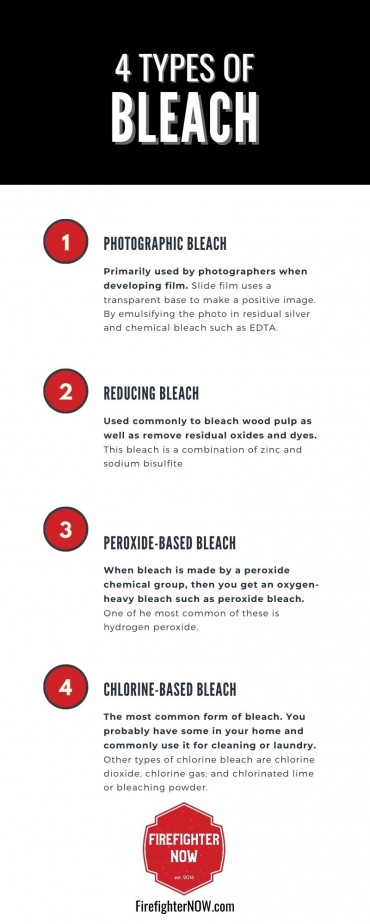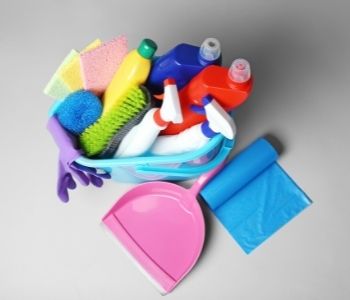Whether to dye your hair or clean your bathroom, most people have used or encountered bleach a time or two. It has a strong smell and is quite noxious for human health. Should a house fire occur in a room with bleach, is the stuff flammable?

Bleach is not considered flammable, but bleach with sodium hypochlorite could explode if exposed to high heat. When using bleach, its chemicals could strengthen a fire, as the chemicals are oxidizers.
If you want to learn all about the dangers of bleach, you’ve come to the right place. First, we’ll talk about the ingredients in bleach and their flammability. Then we’ll discuss the health risks of bleach exposure.
Let’s get started!
Table of Contents
What Is Bleach? Are there different types?
First, let’s talk a bit about bleach. This chemical can clean stains and suck away color. Bleach is also a bactericidal product, which means it can sterilize surfaces from bathrooms to swimming pools. Algae, viruses, and bacteria don’t stand a chance against it.
Bleach comes in four classes: photographic bleach, reducing bleach, peroxide bleach, and chlorine bleach. Let’s explore each of these classes now.
- Photographic Bleach
Wait, photographic bleach as in photographs taken on a camera?
That’s right. Reversal film, aka slide film, uses a transparent base to make a positive image. By emulsifying the photo in residual silver and chemical bleach such as ethylenediaminetetraacetic acid or EDTA, what results is a soluble silver salt.
Using a conventional fixer, the reduced silver dissolves but the silver halide remains. The halide is unexposed, but by introducing a light source, that changes. Now the photo undergoes another development process to make the positive image.
- Reducing Bleach
The second class of bleach is reducing bleach, which uses sodium hydrosulfite or sodium dithionite. The bleach is a combination of zinc and sodium bisulfite. Reducing bleach can bleach wood pulp as well as remove residual oxides and dyes.
- Peroxide-Based Bleach
When bleach is made by a peroxide chemical group, then you get an oxygen-heavy bleach such as peroxide bleach. Examples of peroxide-based bleach are potassium persulfate, benzoyl peroxide, peracetic acid, sodium perborate, sodium percarbonate, and hydrogen peroxide.
- Chlorine-Based Bleach
The last class of bleach is the most common, chlorine-based bleach. This is the household bleach you likely have in your pantries or down your basement.
Chlorine bleach is usually made from sodium hypochlorite, which is referred to as liquid bleach. Liquid bleach cleans swimming pools, treats water, disinfects household surfaces, and improves the color of dingy laundry.
Other types of chlorine bleach are chlorine dioxide, chlorine gas, and chlorinated lime or bleaching powder.

Is Bleach Flammable?
Since the average person only has access to chlorine-based bleach such as that from sodium hypochlorite, that’s what we’ll talk about in this section.
Sodium hypochlorite or liquid bleach is in a water solution that comprises three to six percent of the formula. In some formulas, the amount of liquid bleach can be five to 10 percent, but it’s usually no greater than that.
Liquid bleach, when used alone, is not flammable. When something is flammable, it means that even when in ambient temperatures, it can ignite or combust.
However, the chemicals that liquid bleach gives off when you use it could be flammable. The chemicals are oxidizers. Oxidizing agents receive a high number of electrons.
If a fire already occurred in your home, the chemicals in chlorine bleach that are working as oxidizers could make the fire spread more. However, the bleach on its own would not start a fire.
What’s more serious is that bleach can explode. Combining chlorine bleach with ammonia or acetylene ramps up the oxidizers to the degree that explosions are likelier to occur.
Swimming pool owners have also found that if they store chlorine bleach in a hot environment such as a storage shed in their yards that the bleach can turn into gas. This is known as off-gassing.

If the vaporous bleach can vent out, then–while it’s not safe to breathe in, of course–it’s essentially no harm, no foul. However, in environments where the bleach vapors cannot vent, they can explode.
What Happens If You Burn Bleach?
We’re not assuming that you’re going to heat up or burn bleach on purpose, but it can happen. For example, maybe you cleaned your stovetop with bleach this morning, but you accidentally left some bleach residue.
Later that night, you cook on your stovetop and the remaining bleach heats up. Is this a risky situation?
Yes, for several reasons. For one, you should never leave bleach residue on cooking surfaces. The bleach could transfer to your food. If you ingest bleach, you should contact poison control immediately, as consumption can be deadly.
Even if the bleach gets nowhere near your food, heating sodium hypochlorite or liquid bleach can lead to the production of chlorine gas. In its gas form, chlorine is toxic since it’s highly water-soluble.
The gaseous chlorine can affect your lower and upper respiratory tract alike, leading to throat burning and pain. You could develop symptoms such as a runny nose, watery eyes, coughing, and breathing issues.
If the concentration is high enough, you could experience delayed pulmonary edema, lower pulmonary injuries, and/or bronchospasms, says this 2021 report. Further, symptoms including vomiting, pneumonia, fluid in your lungs, chest pain, and breathing issues could occur.
Should you have accidentally heated or burned bleach and you’re experiencing any of the above symptoms, you should exit the house or building immediately (with any loved ones who were also exposed) and call 911 for medical treatment.
There’s no antidote for bleach exposure or poisoning, but a team of medical professionals can provide inhaled breathing treatments that should help.
Tips for Using Bleach in Your Home
We don’t want to scare you or make you think that you can’t use bleach in your house or in your swimming pool. You certainly can! Just keep these safety tips in mind whenever you handle bleach.
Wear Protective Equipment
Since breathing in bleach, getting it in your mouth, or on your skin is not recommended, you should take precautions ahead of cleaning with it. Wear long sleeves and pants. Ideally, you want to choose clothing that you don’t care much about in case bleach spills on it.
Consider protective equipment for your face such as goggles and a face mask. Heavy-duty rubber gloves will safeguard your hands.
Know What to Do If Exposed to Bleach
Time is of the essence if you were exposed to bleach, either through ingestion or on the skin or clothing.
The Centers for Disease Control and Prevention or CDC suggests that after consuming bleach that you call 911 immediately for poison control assistance. You should not consume any fluids, even water, nor should you try to induce vomiting. Just wait for the medical professionals to arrive and help you.

If you got bleach on your clothes, don’t pass it off as no big deal. The bleach can seep through the clothing to your skin. Get somewhere in your home where you can remove your clothing. If you have to pull your clothes over your head and face to get them off, then cut them away using scissors.
Next, step into the shower. Using water and soap, clean any exposed areas. This can prevent chemical burns from developing on your skin. When you’re out of the shower, put the bleach-stained clothes in at least two layers of plastic bags. Later, you can contact your health department to have them dispose of the clothing.
For now, even though you cleaned your skin, it’s a good idea to see a medical professional immediately for further assessment.
What if you get bleach in your eyes? Use water to flush your eyes for between 10 and 15 minutes. You should take out contacts if you wear them before you start flushing. If you’re a glasses wearer, clean them before putting them back on. Again, seek medical treatment.
Always Dilute Bleach
It’s a horrible idea to pour straight bleach on household surfaces or in your swimming pool. Bleach can discolor and stain what it comes into contact with. Dilute the bleach with water, the amount of which should be recommended on the jug or bottle.
Try Bleach Alternatives
If you’d rather not risk your health, you don’t have to use bleach at all. Try cleaning surfaces with good, old-fashioned soap and water first.
If that doesn’t work, then combine ¾ cups of water with a tablespoon of glycerin and 2 ¼ cups of liquid castile soap. Then squeeze out 10 drops of your favorite essential oil. This pleasant-smelling cleaner isn’t as dangerous as bleach but should be nearly as powerful.
You can also mix ¼ cup of vinegar or lemon juice with ¼ cup of borax and half a cup of the above cleaner for even greater scouring power.
Given bleach’s status as a common household cleaner, it’s sometimes easy to forget about how risky the stuff can be to human health. Bleach itself is not flammable, but its chemicals can encourage a fire to grow. Liquid bleach can also explode in certain conditions.
Always handle bleach with care and you can continue to keep yourself and your family safe!